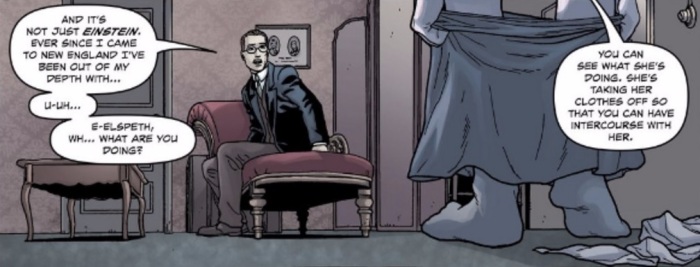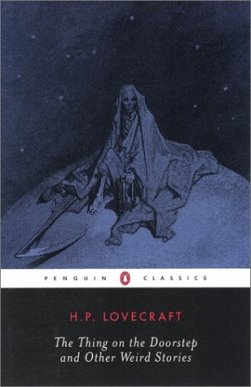Obscenity: Alan Moore and the Miller Test
by Bobby Derie — 2015
In Providence #6 by Alan Moore and Jacen Burrows, the character of Elspeth Wade is portrayed as a 13-year old girl. During the course of the issue, this character strips nude and is raped.

While no penetration is shown, readers in the United States might be honestly concerned as to whether or not this constitutes child pornography under current laws. Given the personal interest this might invoke in readers of this comic, a review of the actual laws involved might be beneficial.
The First Amendment to the Constitution of the United States states that “Congress shall make no law […] abridging the freedom of speech, or of the press.” However, the United States Supreme Court recognizes several exceptions to free speech, specifically affirming that obscenity and child pornography are not considered forms of protected speech under the First Amendment, and that the Federal and state governments can pass laws restricting such works. (Miller v. California 413 U.S. 15 (1973), New York v. Ferber, 458 U.S. 747 (1982))
Laws restricting or outlawing child pornography are enacted to protect children from sexual abuse and exploitation, but in the case of comic books, where no actual child is depicted or harmed, lawmakers have to tackle with more fundamental issues of free speech. To address this, the PROTECT ACT of 2003 was passed into law, and contained a provision specifically regarding artistic depictions of child pornography: 18 U.S. Code § 1466A. This law makes it illegal to produce, distribute, receive, or possess with intent to distribute visual depictions of child pornography—provided they are obscene, or “lacks serious literary, artistic, political, or scientific value.” The constitutionality of the law has not yet been fully tested, and it remains to be seen if the PROTECT ACT would hold up under judicial scrutiny. But given that it currently is law, two questions need to be asked: is the rape sequence in Providence #6 pornographic, and is it obscene?
Well, the character of Elspeth Wade is nude, and does engage in sexual intercourse. However, the definitions given in 18 U.S. Code § 2256 specify “graphic sexual intercourse, including genital-genital, oral-genital, anal-genital, or oral-anal, whether between persons of the same or opposite sex, or lascivious simulated sexual intercourse where the genitals, breast, or pubic area of any person is exhibited.” At no point in the issue are the character’s genitals depicted, and there is no depiction of genital-genital contact. However, as the character is nude, that might bring the Dost Test into play. The Dost Test is a set of guidelines for determining if an image of a minor is a “lascivious exhibition” under 18 U.S. Code § 2256. Given the sexual nature of the events in the comic and the ambiguity of those guidelines, it seems likely that a judge or prosecutor could determine it was pornographic if they chose to. (United States v. Dost, 636 F. Supp. 828 (1986))
The ultimate question, then, is whether or note the Providence sequence is obscene, which requires the administration of the Miller Test for obscenity:
A work may be subject to state regulation where that work, taken as a whole, appeals to the prurient interest in sex; portrays, in a patently offensive way, sexual conduct specifically defined by the applicable state law; and, taken as a whole, does not have serious literary, artistic, political, or scientific value.
Miller v. California 413 U.S. 15 (1973)
Breaking this down into its constituent parts, it seems obvious that the series as a whole, or the individual issue as a whole, does not appeal to prurient interest in sex: the bulk of the issue is given over to ruminations on a fictional grimoire. The sequence where Elspeth Wade’s body is raped may meet the definitions of the applicable law, as an underage character is depicted nude (her breasts are seen, but no genitalia), even if no genital-genital contact is shown. We can probably generally rule out political and scientific value. Artistically, Jacen Burrows’ art is technically excellent, but it is difficult to determine whether that alone qualifies as having “serious value,” though prosecutors might have a difficult time arguing against the overall artistic merit shown in Providence.
From a literary standpoint, I do believe the sequence has serious literary value. In The Horror of Rape, I put forth the argument that Moore has never used rape without a purpose in his works; even the instances with the Invisible Man and Hyde and Pollyanna in League of Extraordinary Gentleman, though played for laughs, served the purpose of comic relief—blackly comic, it is true, but not without some purpose.

In this specific incident in Providence #6, I read the episode as a commentary on H. P. Lovecraft’s “The Thing on the Doorstep.” In that story, Asenath Waite (more specifically a malevolent wizard entity occupying her body) is married to Edward Derby, and the two become engaged in a contest where Waite is switching bodies with Derby. In the story, Lovecraft never examines the lascivious possibilities of this gender-swapping (except for one possible hint), but recall what Alan Moore said about Neonomicon:
This is a horror of the physical with Lovecraft – so I wanted to put that stuff back in. And also, where Lovecraft being sexually squeamish, would only talk of ‘certain nameless rituals.’ Or he’d use some euphemism: ‘blasphemous rites.’ It was pretty obvious, given that a lot of his stories detailed the inhuman offspring of these ‘blasphemous rituals’ that sex was probably involved somewhere along the line. But that never used to feature in Lovecraft’s stories, except as a kind of suggested undercurrent.
So I thought, let’s put all of the unpleasant racial stuff back in, let’s put sex back in. Let’s come up with some genuinely ‘nameless rituals’- let’s give them a name. So those were the precepts that it started out from, and I decided to follow wherever the story lead.
(“Alan Moore: Unearthed and Uncut”)
In that context, this scene doesn’t look like Moore and Burrows are attempting a bit of prurience, as much as they are showing some of the physical horrors that Lovecraft left off the page in “The Thing on the Doorstep.” We never get even a hint in Lovecraft of how the possibility of switching genders might change the dynamic of the sexual relationship between Asenath and Derby, or how such a physical, sexual assault might parallel or complement the psychic contest of domination that had subsumed their normal relationship with each other.
Need it have been sexual? Probably not; non-sexual violence might have as easily underlined the power struggle between Black and Wade. Yet it is also true that Black’s sexuality has been an important aspect of his character, and it will be interesting to see what the long-term effects of this temporary gender reversal and assault will have on Black. Moore has made a habit of using sexual assault as catalysts for change within his characters, such as Janni Dakkar in League of Extraordinary Gentlemen: Century (2009), and it may be that in the context of the entire work, this may turn out to be a key scene in the development of Black’s character and the entire Providence narrative.
This is, of course, not the first time that Moore has flirted with this kind of controversy. Lost Girls (2006) with Melinda Gebbie, also depicts underage characters engaging in sex, albeit in much more explicit detail than in Providence. As of this writing, no one in the United States has been charged with child pornography or obscenity for producing, distributing, receiving, or possessing a copy of Lost Girls, and in other countries that work has avoided the label of “child pornography” due to its literary merit. (“Lost Girls’ Cleared”)
Which bodes well for Providence. However, the individual laws and definitions of child pornography vary from state to state, and the legal opinion of authorities in Canada or the United Kingdom do not determine verdicts in the United States legal system; it is impossible to say definitively that Providence will not spur some legal interest at some point.
But it is important that readers keep these questions of free speech in mind. For those readers that are interested in comics as literature for adults, and not just simply a medium exclusive to children, it still a struggle about what creators are and are not allowed to create, and what readers are and are not allowed to read.
Works Cited
- “Alan Moore: Unearthed and Uncut” (2010). By Bram E. Gieben. Weaponizer. Retrieved from: https://web.archive.org/web/20130626013148/http://www.weaponizer.co.uk/onearticle.php?category=nonfic&articleid=181
- “‘Lost Girls’ Cleared by British Customs Despite Law Banning Sexual Imagery [Exclusive]” (30 September 2010) by Laura Hudson. Comics Alliance. Retrieved from: http://comicsalliance.com/lost-girls-britain-alan-moore/
- Miller v. California 413 U.S. 15 (1973)
- New York v. Ferber, 458 U.S. 747 (1982)
- United States v. Dost, 636 F. Supp. 828 (1986)